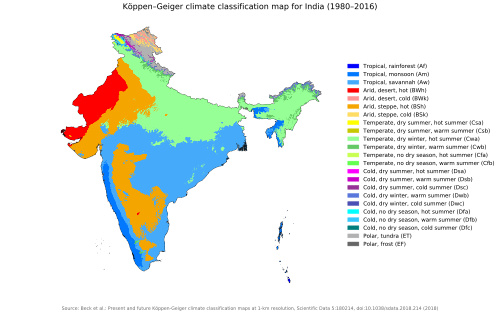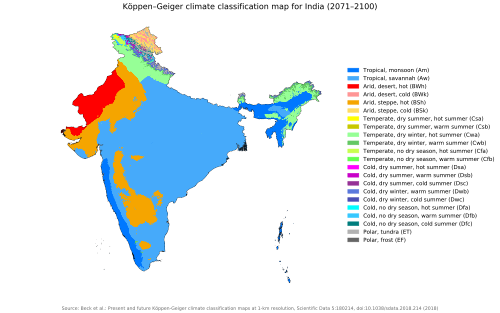Climate change in India

Temperatures in India have risen by 0.7 °C (1.3 °F) between 1901 and 2018.[7]
According to some current projections, the number and severity of droughts in India will have markedly increased by the end of the present century.[8]
Greenhouse gas emissions

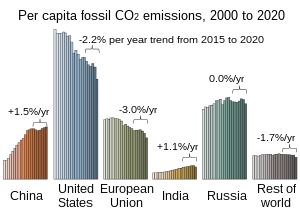
As of 2019[update] these figures are quite uncertain, but a comprehensive
The Paris Agreement commitments included a reduction of this intensity by 33–35% by 2030.[16] India's annual emissions per person are less than the global average,[17] and the UNEP forecasts that by 2030 they will be between 3 and 4 tonnes.[3]
In 2019 China is estimated to have emitted 27% of world GhG, followed by the US with 11%, then India with 6.6%.[18]
The
Electricity generation
As of September 2021 India generates 39.8% of its electricity from
Coal fired power stations
As well as
Household fuel
Switching from traditional fuels to liquefied petroleum gas and electricity provides health and climate benefits.[22]
Industry
A quarter of emissions are industrial[23] mainly from producing cement,[24] iron and steel.[25] Industrial sector fuel consumption increased by 406% between 2000 and 2014.[16]
As of 2014, 42% of energy was also consumed by industry.[16]
Agriculture
Agricultural emissions increased 25% between 2005 and 2014, in part due to significant increases in the use of artificial fertilizers and the burning of crops.[16]
Waste
Waste emitted 78 Mt of
Impacts on the natural environment
Temperature and weather changes
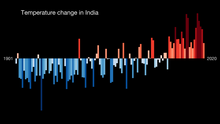
Temperatures in India have risen by 0.7 °C (1.3 °F) between 1901 and 2018, thereby changing the climate in India.[26]
In May 2022 severe heatwave was recorded in Pakistan and India. The temperature reached 51 °C. Climate change makes such heatwaves 100 times more likely. Without climate change heatwaves, more severe that those who occurred in 2010 are expected to arrive 1 time in 312 years. Now they are expected to occur every 3 years.[27]
A 2018 study projects droughts to increase in Northern and North-western India in the near future. Around the end of the century, most parts of India will likely face more and more severe droughts.[28]
Severe landslides and floods are projected to become increasingly common in such states as Assam.[5]
Sea level rise

Meghalaya and other northeastern states are concerned that rising sea levels will submerge much of Bangladesh and spawn a refugee crisis. If severe climate changes occurs, Bangladesh and parts of India that border it may lose vast tracts of coastal land.[29]: 130
Thousands of people have been displaced by ongoing sea level rises that have submerged low-lying islands in the Sundarbans.[30]
Water resources
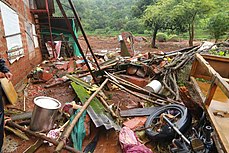
Temperature rises on the Tibetan Plateau are causing Himalayan glaciers to retreat, threatening the flow rate of the Ganga, Brahmaputra, Yamuna, and other major rivers; the livelihoods of hundreds of thousands of farmers depend on these rivers.[31] A 2007 World Wide Fund for Nature (WWF) report states that the Indus River may run dry for the same reason.[4]
Ecosystems
Ecological disasters, such as a 1998 coral bleaching event that killed off more than 70% of corals in the reef ecosystems off Lakshadweep and the Andamans and was brought on by elevated ocean temperatures tied to global warming, are also projected to become increasingly common.[32][33]
Impacts on people
Economic impacts
India has the world's highest social cost of carbon.[34] A report by the London-based global think tank Overseas Development Institute found that India may lose anywhere around 3–10% of its GDP annually by 2100 and its poverty rate may rise by 3.5% in 2040 due to climate change.[35][36]
Reduced crop yields
Climate Change in India will have a disproportionate impact on the more than 400 million that makeup India's poor community. This is because so many depend on natural resources for their food, shelter and income. More than 56% of people in India work in agriculture, while many others earn their living in coastal areas.[37] The impact of climate change on Indian agriculture was investigated through the National Innovations in Climate Resilient Agriculture (NICRA) study. The findings indicate that rainfed rice yields in India are expected to experience a marginal reduction of less than 2.5% in the years 2050 and 2080. On the other hand, irrigated rice yields are projected to decline by 7% in 2050 and 10% in 2080 scenarios. Moreover, the study forecasts a decrease in wheat yield ranging from 6% to 25% in the year 2100, while maize yields are estimated to decrease by 18% to 23% during the same period. However, there is a potential positive impact on chickpea, with anticipated productivity increases of 23% to 54% in the future climates.[38]
Health impacts
Air pollution, which reflects sunlight, and irrigation, which cools the air by evaporation, have counteracted climate change since 1970. These two factors do however increase the impact of heat waves, as both lead to increased mortality.[39]
Heat waves
Heat waves' frequency and power are increasing in India because of climate change. In 2019, the temperature reached 50.6 degrees Celsius, 36 people were killed. The high temperatures are expected to impact 23 states in 2019, up from nine in 2015 and 19 in 2018. The number of heat wave days has increased—not just day temperature, night temperatures increased also. 2018 was the country's sixth hottest year on record, and 11 of its 15 warmest years have occurred since 2004. The capital New Delhi broke its all-time record with a high of 48 degrees Celsius.[40]
In India, exposure to heat waves is said to increase by 8 times between 2021 and 2050, and by 300% by the end of this century. The number of Indians exposed to heat waves increased by 200% from 2010 to 2016. Heat waves also affect farm labour productivity. The heat waves affect central and northwestern India the most, and the eastern coast and Telangana have also been affected. In 2015, the latter places witnessed at least 2500 deaths. In 2016, for the first time in history, Kerala reported a heat wave. The government is being advised by the Indian Institute of Tropical Meteorology in predicting and mitigating heat waves. The government of Andhra Pradesh, for instance, is creating a Heat Wave Action Plan.[41]
The death toll from India's heat waves has decreased in the last four years. More than 2,000 people died in 2015, 375 in 2017 and 20 in 2018. "Officials say this is because the government has made an effort to reduce the death toll by encouraging residents to reduce or alter the time spent working on hot days and by providing free drinking water to hard-hit populations". It also used water to cool streets and forced police to guard water tankers in Madhya Pradesh state after fights oversupply turned deadly. Those measures cost a lot of money and water, and the government's resources were limited in 2019 by the country's national election. The heat wave may continue, as monsoon rains have been delayed this year.[42][needs update]
Impacts on migration
Around seven million people are projected to be displaced due to, among other factors, submersion of parts of Mumbai and Chennai, if global temperatures were to rise by 2 °C (3.6 °F).[43]
By the year 2050, India is expected to witness a significant increase in climate-related displacement, with around 45 million people compelled to migrate from their homes due to climate disasters. This number is three times higher than the current count of individuals being displaced because of extreme weather events. According to the "State of India's Environment-2022" report, India ranks as the fourth worst-affected country globally in terms of climate change-induced migration, with over three million people forced to abandon their residences in the year 2020-2021. These statistics emphasize the escalating impact of climate change on migration patterns within the country.[44]
Villagers in India's North Eastern state of Meghalaya are also concerned that rising sea levels will submerge neighboring low-lying Bangladesh, resulting in an influx of refugees into Meghalaya which has few resources to handle such a situation.[45][46]
Mitigation

Greenhouse gas sinks
Energy policy
The National Energy Plan is in accord with the Paris Agreement target of 2 °C global warming, but if India stopped building coal-fired power stations it would meet the 1.5 °C aspiration.[48] India pledged to achieve electric power generation of 40% percent non-fossil fuel energy by 2030.[16]
In its Biennial Update Report to the United Nations Framework Convention on Climate Change (UNFCCC) submitted in February, India said it has progressively continued decoupling of economic growth from greenhouse gas emissions. India's emission intensity of gross domestic product (GDP) has reduced by 24% between 2005 and 2016. India is therefore on track to meet its voluntary declaration to reduce the emission intensity of GDP by 20–25% from 2005 levels by 2020, making India the only G20 nation to meet climate goals.[49]
India's
With accelerated coal plant closures, and an anticipated surge in renewables, thermal power will account for only an estimated 42.7% of installed capacity across India by 2027, down dramatically from 66.8% in 2017.[52]
Cutting greenhouse gas emissions, and therefore air pollution in India, would have health benefits worth 4 to 5 times the cost, which would be the most cost-effective in the world.[15]
India has made significant strides in the
Policies and legislation
The Indian Government as well as various state governments have taken certain steps in accordance with India's energy policy and the Paris Agreement. Following are some of those steps:
- Doubling India's renewable energy target to 450 gigawatt (GW) by 2030 [54]
- National Solar Mission
- Wind power in India
In 2008, India published its
While presenting the fiscal year 2020-2021 state budget for the Indian state of Odisha, Finance Minister of the state Niranjan Pujari introduced the Climate Budget.[56] Climate budget aims to keep track of the expenses made by the government for climate change or to support mitigation and adaption actions to address climate change. As per the document, It will help the government to decide whether to redesign or safeguard the existing projects by seeing their impact on the climate change.[57] Odisha has become the first state in India to introduce climate budget.[58]
Carbon emission trading and pricing
Carbon emission trading is yet to be implemented in India. However, related instruments such as energy saving certificates (PAT), various renewable purchase obligations (RPO), and renewable energy certificates (REC) are traded on the power exchanges regularly.[60][61]
India does not have a carbon tax, but since 2010 the country has had a tax on both domestically produced and imported coal, which powers more than half of its electricity generation.[62] Originally set at ₹50 (63¢ US) per tonne of coal, it was raised to ₹100 in 2014[63] and ₹200 in 2015. As of 2020 the coal tax stands at ₹400 (US$5.00) per tonne.[64]
International cooperation
As a party to the
At
- Reaching carbon neutrality by 2070.
- Expand the energy capacity not coming from fossil fuels to 500GW by 2030.
- Cut the carbon intensity of economy by 45% by 2030.
- Draw half of its energy requirement from renewable sources by 2030.
- Cut 1 billion tons of GHG emission from the amount projected to the year 2030.
The prime minister also proposed to advance a new agenda: LIFE - Lifestyle for Environment, meaning changing lifestyle for benefit the environment.[69]
Even though the date of net zero is far behind that of China and the US and India's government wants to continue with the use of coal, Indian environmentalists and economists applauded the decision, describing it as a bold climate action.[70]
Adaptation
An
A research project conducted between 2014 and 2018 in the five districts (Puri, Khordha, Jagatsinghpur, Kendrapara and Bhadrak) of Mahanadi Delta, Odisha and two districts (North and South 24 Parganas) of Indian Bengal Delta (includes the Indian Sundarbans), West Bengal provides evidence on the kinds of adaptations practiced by the delta dwellers. In the Mahanadi delta, the top three practiced adaptations were changing the amount of fertiliser used in the farm, the use of loans, and planting of trees around the homes. In the Indian Bengal Delta, the top three adaptations were changing the amount of fertiliser used in the farm, making changes to irrigation practices, and use of loans. Migration as an adaptation option is practiced in both these deltas but is not considered as a successful adaptation.[72]
In the Indian Sundarbans of West Bengal, farmers are cultivating salt-tolerant rice varieties which have been revived to combat the increasing issue of soil salinity. Other agricultural adaptations include mixed farming, diversifying crops, rain water harvesting, drip irrigation, use of neem-based pesticide, and ridge and farrow land shaping techniques where "the furrows help with drainage and the less-saline ridges can be used to grow vegetables". These have helped farmers to grow a second crop of vegetables besides the monsoon paddy crop.[73]
In Puri district of Odisha, water logging is a hazard that affects people yearly. In the Totashi village, many women are turning the "water logging in their fields to their advantage" by cultivating vegetables in the waterlogged fields and boosting their family income and nutrition.[74] Education Education is an integral tool that can be used in the adaptation of the measures that have been put in place to curb climate change. When considering the adaptation of measures that have been established to curb climate change, it is important to ensure that the education system has been included in such a project.₳ By improving people's knowledge of climate change, it would be easier for them to adopt different mitigation measures. Also, there is a need to instill a culture among the younger generation on the best practices when it comes to environmental matters. The government must seek to ensure that systems that support learning, which undergirds adaptation are supported to enhance adaptation.
Society and culture
Media coverage
A qualitative analysis of some mainstream Indian newspapers (particularly opinion and editorial pieces) during the release of the
Activism

Calculations in 2021 showed that, for giving the world a 50% chance of avoiding a temperature rise of 2 degrees or more India should increase its climate commitments by 55%.[78]: Table 1 For a 95% chance it should increase the commitments by 147%. For giving a 50% chance of staying below 1.5 degrees India should increase its commitments by 191%.[78]
There have been
Tribal people in India's remote northeast planned to honor former U.S. Vice President Al Gore in 2007 with an award for promoting awareness on climate change that they say will have a devastating impact on their homeland.[80]
Meghalaya- meaning 'Abode of the Clouds' in Hindi—is home to the towns of Cherrapunji and Mawsynram, which are credited with being the wettest places in the world due to their high rainfall. But scientists state that global climate change is causing these areas to experience an increasingly sparse and erratic rainfall pattern and a lengthened dry season,[81] affecting the livelihoods of thousands of villagers who cultivate paddy and maize. Some areas are also facing water shortages.
People are becoming aware of the ills of global warming. Taking initiative on their own people from Sangamner, Maharashtra (near Shirdi) have started a campaign of planting trees known as Dandakaranya- The Green Movement. It was started by visionary & ace freedom fighter the late Shri Bhausaheb Thorat in 2005. To date, they have sowed more than 12 million seeds & planted half a million plants.
See also
- Climate change adaptation
- Climate change mitigation
- Climate finance
- Plug-in electric vehicles in India
- Climate change in South Asia
References
- ISBN 978-3-943704-49-5. Archived from the original(PDF) on 25 September 2017. Retrieved 10 July 2017.
- ^ a b "Greenhouse Gas Emissions in India" (PDF). September 2018. Archived (PDF) from the original on 2020-02-14. Retrieved 10 June 2021.
- ^ a b c "Emissions Gap Report 2019". UN Environment Programme. 2019. Archived from the original on 2019-11-20. Retrieved 10 June 2021.
- ^ a b "How climate change hits India's poor". BBC News. 1 Feb 2007. Retrieved 10 June 2021.
- ^ a b "Warmer Tibet can see Brahmaputra flood Assam | India News - Times of India". The Times of India. 3 February 2007. Retrieved 2021-03-11.
- ^ "Climate Change Performance Index" (PDF). November 2022. Retrieved 15 November 2022.
- Tribune India. Retrieved 30 November 2020.
- S2CID 135053362.
- ^ ISSN 1866-3516.
- ^ a b "The Carbon Brief Profile: India". Carbon Brief. 2019-03-14. Retrieved 2019-09-25.
- ^ Government of India (2018) India Second Biennial Update Report to the United Nations Framework Convention on Climate Change
- ^ a b "India: Third Biennial Update Report to The United Nations Framework Convention on Climate Change" (PDF). Archived (PDF) from the original on 2021-02-27.
- ^ "By 2030, Cut Per Capita Emission to Global Average: India to G20". The Leading Solar Magazine In India. 26 July 2021. Retrieved 2021-09-17.
- ^ "A comprehensive GHG inventory for India is within reach". www.downtoearth.org.in. Retrieved 2019-09-25.
- ^ PMID 32006762.
- ^ a b c d e "Greenhouse Gas Emissions Factsheet: India". Climatelinks. 31 January 2019. Retrieved 2020-04-23.
- ^ Roche, Elizabeth (2021-09-05). "India, US to focus on financing green technologies during John Kerry's visit". mint. Retrieved 2021-09-17.
- ^ "Report: China emissions exceed all developed nations combined". BBC News. 2021-05-07.
- ^ "Power Sector at a Glance ALL INDIA | Government of India | Ministry of Power". Powermin.gov.in. Retrieved 2022-08-11.
- ^ "India, World's No. 2 Coal Buyer, Plans to Cut Imports by a Third". Bloomberg.com. August 2019. Retrieved 2019-09-27.
- ^ "How Long Will Coal Remain King in India?". www.greentechmedia.com. Retrieved 2021-01-21.
- S2CID 212937766.
- ^ "India's Industrial Sector GHG Emissions". www.ghgplatform-india.org. Retrieved 2020-04-20.
- S2CID 209766770.
- ^ a b c 2nd biennial report (2018), p. 8.
- ^ Sharma, Vibha (15 June 2020). "Average temperature over India projected to rise by 4.4 degrees Celsius: Govt report on impact of climate change in country". Tribune India. Retrieved 2020-11-30.
- ^ Rowlatt, Justin (18 May 2022). "Climate change swells odds of record India, Pakistan heatwaves". BBC. Retrieved 20 May 2022.
- S2CID 135053362.
- ^ Hossain, M. (2011), "Climate Change Impacts and Adaptation Strategies for Bangladesh", Climate Change and Growth in Asia, Edward Elgar Publishing (published 11 May 2011),
- ^ "How climate change hits India's poor". 2007-02-01. Retrieved 2021-03-11.
- ^ Sethi, Nitin (February 3, 2007). "Global warming: Mumbai to face the heat". The Times of India. Retrieved 2021-03-11.
- S2CID 128503395.
- ^ Aggarwal, D., Lal, M. Vulnerability of the Indian Coastline to Sea Level Rise (SURVAS Flood Hazard Research Centre)
- ^ "New study finds incredibly high carbon pollution costs – especially for the US and India". The Guardian. 1 October 2018.
- ^ "India may lose 3-10% GDP annually by 2100 due to climate change, says report". The Indian Express. 2021-06-09. Retrieved 2021-07-01.
- ^ "The costs of climate change in India: a review of the climate-related risks facing India, and their economic and social costs". Overseas Development Institute. 7 June 2021. Archived from the original on 2021-06-08. Retrieved 2021-07-01.
- ^ UNDP. "India and Climate Change Impacts". Archived from the original on 2011-03-17. Retrieved 2010-02-11.
- ^ "Effect of Climate Change on Agriculture". PIB.GOV.IN. Retrieved 26 July 2023.
- ISSN 1561-8633.
- ^ "2018 Was Sixth Warmest Year in India's Recorded History: IMD". The Wire. Retrieved 2020-10-30.
- ^ Alexander, Usha. "Ecological Myths, Warming Climates and the End of Nature". The Caravan. Retrieved 2019-07-17.
- ^ Rosane, Olivia (June 13, 2019). "36 Die in India Heat Wave, Delhi Records Its Highest All-Time Temperature". Ecowatch. Retrieved 14 June 2019.
- ^ Sethi, Nitin (3 February 2007). "Global warming: Mumbai to face the heat". The Times of India. Archived from the original on 23 October 2012. Retrieved 2007-03-18.
- ^ Murali Krishnan. "India: Migration from climate change getting worse". DW. Retrieved 26 July 2023.
- ^ "Meghalaya body's Shylla wary of refugee influx". www.telegraphindia.com. Retrieved 2020-11-30.
- S2CID 199493022.
- ^ "Carbon stock in forests: Kerala tops among south Indian states". Mathrubhumi. 23 April 2020. Retrieved 2020-04-23.
- ^ "Climate change report card: These countries are reaching targets". Environment. 2019-09-19. Archived from the original on 2019-09-20. Retrieved 2019-09-26.
- ^ "'India only G20 nation to meet climate goals'". 16 August 2021.
- S2CID 258753397. Retrieved 2023-06-07.
- ^ "Renewable Methanol" (PDF). Retrieved 19 May 2021.
- ^ "IEEFA India: New National Electricity Plan Reinforces Intent Toward 275 Gigawatts of Renewables-Generated Electricity by 2027". 19 April 2018. Archived from the original on 2019-09-26.
- ^ "India ranks 3rd in the 'Renewable Energy Country Attractiveness Index' released by EY". www.ey.com. Retrieved 2021-07-01.
- ^ Jai, Shreya (25 September 2019). "Govt to ease land acquisition, finance for renewables to meet 450 GW target". Business Standard India. Archived from the original on 2019-09-26.
- ^ King et al. 2012. "The Response of China, India, and Brazil to Climate Change." Archived 2014-05-09 at the Wayback Machine Smith School of Enterprise and the Environment. University of Oxford.
- ^ "Odisha first state to have 'climate, nutrition budgets' - OrissaPOST". Odisha News, Odisha Latest news, Odisha Daily - OrissaPOST. 18 February 2020.
- ^ "Odisha Becomes First State To Introduce Climate Budget". OdishaTV. 18 February 2020.
- ^ Suffian, Mohammad (February 19, 2020). "Odisha govt presents Rs 1.5 lakh crore budget for FY21". India Today.
- ^ "Carbon Capture, Utilization and Storage (CCUS) - Policy Framework and its Deployment Mechanism in India" (PDF). Niti Aayog. November 2022. Retrieved 11 December 2022.
- ^ "Renewable energy: The undoing of RECs and ESCerts". 17 June 2022. Retrieved 2 October 2022.
- ^ "To price or not to price? making a case for a carbon pricing mechanism for India" (PDF). Retrieved 2 October 2022.
- ^ Pearson, Natalie Obiko (1 July 2010). "India to Raise $535 Million From Carbon Tax on Coal". Bloomberg Businessweek. Archived from the original on 4 July 2010. Retrieved 14 May 2011.
- ^ Dogra, Sapna (3 July 2010). "India sets $1/mt clean coal tax for domestic producers/importers". Platts International Coal Report. Archived from the original on 21 February 2021. Retrieved 4 September 2016.
- ^ "Controlling emissions: Explicit carbon taxation needed, indirect taxation doesn't help". The Financial Express. 2020-09-04. Archived from the original on 9 July 2021. Retrieved 2021-07-06.
- ^ "Reporting and Review under the Paris Agreement". unfccc.int. Retrieved 2020-04-20.
- ^ "Climate change: Whisper it cautiously... there's been progress in run up to COP26". BBC. 25 September 2021. Retrieved 10 October 2021.
- ^ —
- Webster, Ben; Burgess, Kaya; Philp, Catherine (1 November 2020). "Cop26: India puts off net zero to 2070 and deals blow to climate hopes". The Times.
- Vittozzi, Katerina (1 November 2021). "COP26: India has given a distant net-zero target and is now asking the world for cash". Sky News.
- "COP26: India PM Narendra Modi pledges net zero by 2070". BBC News. 2 November 2021.
- ^ Vaughan, Adam (2 November 2021). "COP26: Why India's 2070 net zero pledge is better news than it sounds". New Scientist.
- ^ Shrivastava, Rahul (1 November 2021). "Push for renewable by 2030, net-zero emissions by 2070: PM Modi's 5 commitments at COP26 summit". India Today. Retrieved 21 November 2021.
- ^ "India pledges net-zero emissions by 2070 — but also wants to expand coal mining". NPR. 3 November 2021.
- ^ Krug, Teresa (7 May 2018). "Sonam Wangchuk: An Ice Fountain Brings Water to the Himalayan Desert". Guernica Magazine. Retrieved 7 June 2018.
- ^ "Climate change, migration and adaptation in deltas: Key findings from the DECCMA project". weADAPT | Climate change adaptation planning, research and practice. 2018-10-31. Retrieved 2020-11-29.
- ^ "Salt-tolerant rice, innovations help farmers deal with salinity in Sundarbans". Mongabay-India. 2020-07-14. Retrieved 2020-11-29.
- ^ "Women Adapting to Climate Change by undp india on Exposure". undp-india.exposure.co. Retrieved 2020-11-29.
- .
- hdl:1959.14/181298.
- S2CID 18426714.
- ^ PMID 33899003.
- ^ "'Key conspirator, collaborated with pro-Khalistani body': Delhi Police on Disha Ravi, arrested in toolkit case". The Indian Express. 2021-02-14. Retrieved 2021-02-14.
- ^ Das, Biswajyoti (2007-08-29). "India tribe to honour Gore on global warming". Reuters. Retrieved 2007-09-08.
- ^ Kharmujai RR (3 March 2007). "Wet Desert Of India Drying Out". Retrieved 2007-12-01.
Bibliography
- "Second Biennial Update Report" (PDF). Ministry of Environment, Forest and Climate Change. December 2018.
Further reading
- Malone, David M., C. Raja Mohan, and Srinath Raghavan, eds. The Oxford handbook of Indian foreign policy (2015) excerpt pp 663–680.
- "Nationally Determined Contributions submitted to UN". www4.unfccc.int. Retrieved 2019-10-31.

